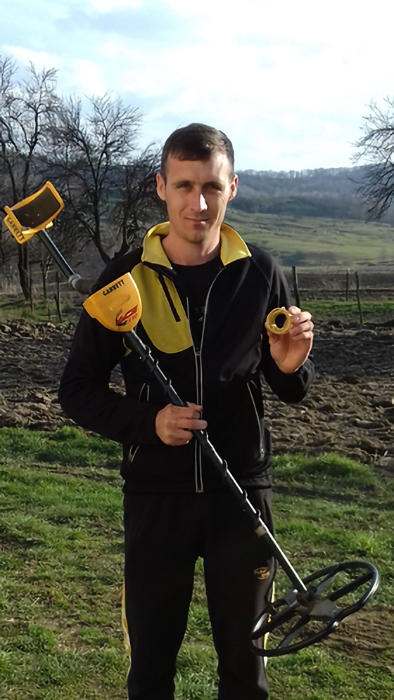Jan Bartek – AncientPages.com – It is not the first time Betej Gabriel, an amateur archaeologist from Gorj in Romania, has made an incredible find using his metal detector. So, when he contacted Ancient Pages and told us about his new archaeological discovery, we were naturally eager to learn more.

Using his metal detector, Betej Gabriel stumbled upon an incredible Thracian treasure in the Prigoria forest. Credit and copyright: Betej Gabriel – used with permission
Gabriel says he entered the forest with his metal detector on a Saturday afternoon and had no thoughts of coming across something as precious as a Thracian treasure. He had searched in the area on other occasions but without success. Yet, to his astonishment, just about 10 minutes after entering the forest, his metal detector alerted him with a strong signal. He hurried, dug, and unearthed several gold objects that he, at the time, did not know what they were. Gabriel soon realized he had come across something of great archaeological and historical value but was in shock.

The discovery of precious ancient artifacts was unexpected. Credit and copyright: Betej Gabriel – used with permission
“The discovery was made on March 4, 2023, in the Gorj county, Prigoria village. The objects were buried only 30 centimeters in the ground. Experts examined and dated them 1200 B.C. The 7 unearthed gold bracelets belong to Thracians, predecessors of Dacians,” Gabrield told AncientPages.com.
“Both the Thracians and the Dacians were extremely warlike peoples, according to what we know about them from an-
ancient sources and from archaeological researches. They were feared and admired by their enemies, who always had great difficulty in defeating them. The Thracians had lived on the northern edges of the Greek world since the Mycenean period, and thus were well known to the Greeks: they fought against and for the latter on several occasions, contributing in a decisive way to the general development of the Greek art of war.” 1
Surviving artifacts of Thracian culture offer evidence these people were also skilled craftsmen who produced remarkable gold objects.

The Thracian gold bracelets found by Gabriel will be available to view in a museum soon. Credit and copyright: Betej Gabriel – used with permission
The gold bracelets weighing 130 grams were handed over to the Gorj County Museum of History, being cataloged in the “Treasure” category.

The gold bracelets were buried just 30 centimeters in the ground. Credit and copyright: Betej Gabriel – used with permission
“The objects will be inventoried, classified, and exhibited. It is one of the most important or even the most important archaeological discoveries in Gorj county if we consider the metal from which they are made”, said Dumitru Hortopan, director of the Gorj County Museum.
Last year, Gabriel discovered an extremely rare Roman cavalry parade mask in Albeni, a commune in Gorj County.
As previously mentioned on Ancient Pages, Roman-era iron masks are rare, making this a unique find. So far, only bronze Roman masks have been discovered in the country. The iron mask belonged most likely to a Roman soldier stationed in the region.

The Roman mask found by Gabriel last year. Credit: Gorj County Museum
It would seem this region is worthy of further archaeological studies as other ancient objects may be hidden in the ground.
“An evaluation must also be done in the field, in the respective area. Ceramics may also appear, and after the ceramics, you can tell best what period it is. Both the Roman mask and these gold bracelets will bring important earnings to the one who found them. Being exceptional discoveries, he will be rewarded with several tens of thousands of lei. The vestiges are to be expertized and evaluated, then it will be determined what amount is due to the lucky detectorist,” Vasile Marinoiu, archaeologist said.
See also: More Archaeology News
Gabriel is a talented metal detectorist and we can expect to learn more about his discoveries in the near future.
“I’m a history lover and I am very glad to see my discoveries exposed in a museum,” Gabriel told AncientPages.com
Written by Jan Bartek – AncientPages.com Staff Writer
Expand for references
- Gabriele Esposito Armies of the Thracians and Dacians, 500 BC to AD 150





